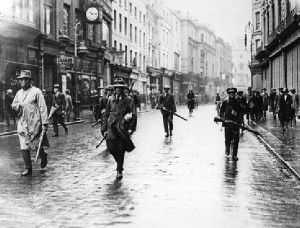One of the most valuable sources when it came to researching the murder of Brendan O’Carroll’s ancestor, were the Witness Statements in the Bureau of Military History collection.
Bureau of Military History Witness Statements
The Bureau of Military History is a collection of some 1700 witness statements as well as photographs, documents and voice recordings. This material was collected by the state between 1947 and 1957 in a bid to document Ireland’s revolutionary period from 1913 to 1921. The witness statements are largely personal accounts written by individuals who were active in the Republican movement. They are their own recollections of the events that they participated in and the statements are peppered with personal bias and opinion. The statements also include attempts to name the men and women with whom the author served. This can sometimes include the rank of each man in a company, a valuable source for anyone investigating the story of their ancestor during this period. It was from various witness statements that we were able to start constructing the story of what happened to Brendan O’Carroll’s grandfather, Peter. Comments recorded by David Nelligan (WS 380) and Peter’s son, Liam (WS 314 and WS 594) pointed to the identity of the perpetrator.
These documents are a vivid and evocative source for a crucial period in Irish history. Even if your ancestor did not submit a witness statement, they may be referred to by someone who did. Even if your ancestor’s name does not appear in the statements, the evidence submitted by someone else who served in the same company should help to paint a picture of the actions that your ancestor may have participated in.
This unique collection has been made available online at the Irish Military Archives. It is possible to search the entire collection for any term, such as a personal name or location. Bear in mind that men may have been known to their comrades by a nickname or used the Irish spelling of their name, so make sure to try different varient spellings of a surname or first name. Most of the Irish Volunteer companies around the country were named for the parish or district that they represented, and this may be one way of identifying statements by men that might have served with your ancestor. Searching for references to a place name may also bring to light activity that took place in that area, such as an ambush or the destruction of a barracks or bridge.
Once you have identified the statements that pertain to the area where your ancestor was active or for the company that they served with you should be able to develop a picture of their experience of the 1916 Rising and the War of Independence.
Military Service Pension Applications
In conjunction with the Bureau of Military History Witness Statements we were further able to expand Brendan O’Carroll’s story using the Military Service Pensions Collection. These records have also recently been digitised and are available online at the Irish Military Archives. The Military Service Pension Applications can be very detailed files in which the applicant often had to justify their request with an extensive account of their activities between 1913 and 1921 as well as supporting documentation such as letters of reference and corroboration. These applications will also provide you with a very detailed account of the activities of a specific individual, which can be used to determine the activities of a company of the Irish Volunteers or members of the same family who were active.
Searching the Witness Statements and Pension Applications for clues to the identity of the man that killed Brendan O’Carroll’s ancestor brought to life the war that was being waged on the dark streets of Dublin City in 1920 and 1921.
